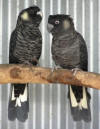. white tailed black cockatoo

Aviary Notes: Level Of Knowledge Required: Beginner / Intermediate / Advanced / Specialist Breeders Only. Government Regulations & By-Laws: Refer to " Government Laws " web page. Housing Requirements: Refer to " Housing Birds " web page for general details on the housing of Cockatoos or read on for specific details for this parrot. An aviary of 8 metres long will allow these birds to be able to get adequate exercise. The aviary should be about 1.5 to 1.8 metres wide and about 2.4 metres high. Heavy gauge wire is necessary, preferably weldmesh. Suitable non-toxic leafy branches can be placed in the aviary for the birds to chew up. This will entertain the birds, help minimize boredom and give the birds some beak exercise. Natural branches can be used for perches. These natural perches will be chewed by the birds and may need to be replaced regularly. Diet / Feeding: Refer to " Feeding Birds " web page for general details on the feeding of Cockatoos or read on for specific details for this parrot. Native diet includes seed cones of Banksia and the introduced Pine species. Branches, seeds and cones of these trees and other suitable native plants should be offered to the birds. This will provide them with hours of physical activity and mental stimulation as well as a varied diet. Aviary diet includes Sunflower seed, Canary seed, almonds, pine cones and other suitable native seed cones. They have a preference for Banksia cones and nuts. Nesting: A basic overview only. Dimensions are typical / average and can vary widely, influenced by the owner's preferences and the birds preferences. Parent bird's preferences can also be influenced by the size and type of nest-box / log in which the bird was hatched and reared. If space allows, offering a choice of sizes and types of logs or nest-boxes, and placed in various locations within the aviary, can allow the parent birds to make their own choice. Once a pair has chosen a specific nest-box/log and been successful in it, offer that one to them each breeding season. Try and keep that one for their exclusive use. Once a pair has chosen its log or nest-box, the other ones can generally be removed. If the "spare" boxes are to be removed and moved to another flight, ensure the log / nest-box is cleaned to ensure the receptacle has the minimal contamination of mites, parasites and pathogens. A solid log is the preferred nest for large cockatoos.
Timber nest-boxes generally require a climbing structure attached inside the box below the entrance hole. Both logs and nests need an entrance hole/opening about 100 - 150mm (about 4 -6 inches) from the top. Many species of parrots like the entrance hole to be just big enough to squeeze through. Some parrot breeders do not place a "top" or lid on the larger nest log or nestbox and allow the birds to enter the nest via the top opening. More details on parrot nestboxes/logs and a selection of parrot nestbox/log photos can be found on the "nests", "parrot nests" and "parrot nestbox photos" web pages. Click on "Up" then "Nests" then "parrot nests" and "parrot nestbox photos" in the navigation bars. Breeding: Egg Colour White. Clutch/s per year 1. Eggs per nest = Usually produce one young per clutch. Incubation approx. 28 days. Fledge approx. 12 weeks. Independent approx .. many months and may be fed by a parent till the parents start the next clutch the next year. Artificial incubation and hand rearing or fostering will not be covered on this web site. It is too complex and diverse in nature to be attempted here. Health Issues: Refer to "Avian Health Issues" web page for information and references.
General References: Refer to references listed on "Book References" web page. Specific References:
|